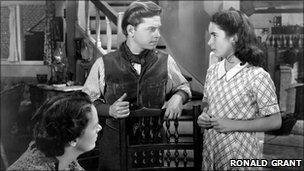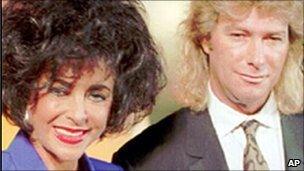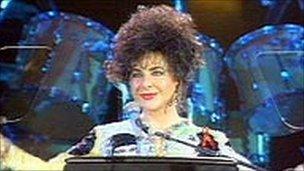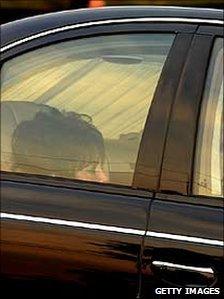Obituary: Elizabeth Taylor
- Published

Her performances never lacked style
With her timeless beauty, on-screen dramas and off-screen theatrics, Elizabeth Taylor was the epitome of Hollywood excess.
Her glamour made her the most highly paid actress of her day and for a long time the most publicised.
Her film career lasted for more than half a century but her private life was more complicated than any storyline, and her romances kept her in the headlines.
She had seven husbands and was married twice to the Welsh actor Richard Burton.
Elizabeth Rosemond Taylor was born in London on 27 February 1932, the daughter of an American art dealer and his actress wife.
She held dual British and American nationality by virtue of having been born on British soil to American parents.
She was taken to Los Angeles as a child and began her film career at the age of nine.
She appeared alongside Roddy McDowall in Lassie Come Home in 1943 and a year later achieved her first great success in National Velvet.
In 1951 she played her first adult lead role in the film Conspirator, in which she co-starred with Robert Taylor.
The film was a flop but Taylor received critical acclaim for her mature portrayal of her 21-year-old character. She was just 16 at the time.

National Velvet made her a child star
Her great breakthrough as an adult actress came when she starred opposite Montgomery Clift in A Place in the Sun. Her beauty from then on became the popular standard for a decade.
Her dramatic range was limited at this early stage of her career, but her performances gained authority and never lacked style as she grew older.
She was nominated for Oscars in 1958, 1959 and 1960 for Raintree County, Cat on a Hot Tin Roof and Suddenly, Last Summer respectively.
By 1961 she was in her element and received an Oscar for her part in Butterfield 8, playing call-girl Gloria Wandrous, who has an affair with a married man and dies in a car crash.
Her private life was also never dull. She was first wed at 18 to Conrad Hilton, the heir to the luxury hotel chain.

Smouldering with Burton in Cleopatra
Four years later she married actor Michael Wilding and they had two children, Chris and Michael.
However, she moved on three years later to film producer Mike Todd, with whom she had a daughter, Liza. When he was killed in an air crash soon afterwards, Taylor was devastated.
Singer Eddie Fisher did his best to comfort her, and soon became husband number four in 1959, in a marriage that lasted five years.
In 1963 she completed work on a lavish production of Cleopatra. It did not enhance her reputation as an actress and her diva behaviour helped push the film's budget past the £12m mark, a colossal sum at the time.
Nevertheless, the press had a field day when news leaked of her new romance with co-star Richard Burton.
Poor reviews
They worked together on several films including Who's Afraid of Virginia Woolf?, for which she won an Oscar in 1967, and Franco Zeffirelli's The Taming of the Shrew. They married in 1964 and later adopted a child, Maria.

Larry Fortensky became her seventh husband. The marriage lasted five years
Their tempestuous relationship kept the gossip columnists busy. A diamond ring he bought her was said to have cost almost £500,000. She joked later that, for a while, she became "very left handed".
In 1973 they divorced in a Swiss court. Two years later, they were again in front of a judge, this time to re-marry in a remote Botswana village.
Their reunion lasted five months, and they were divorced for the second time in 1976.
Then, in Washington, she met and married a former US naval secretary, John Warner, who became a Republican senator.
Her career had reached a plateau, although she insisted she was content growing older and being a politician's wife.
The marriage lasted until 1982.
Clinic romance
The actress suffered poor reviews the following year, when she toured the United States in a production of Private Lives with Richard Burton.

Campaigning for funds in the fight against HIV/Aids at a concert in London in 1992
For the first time, she entered the Betty Ford Clinic for drug and alcohol addiction. Her condition was not helped by Burton's death the following year.
Taylor made several follow-up trips to the clinic, where she encountered builder Larry Fortensky. He was 20 years her junior and had been jailed several times for drink-driving and drug-related offences.
The couple got engaged and, at their private wedding, paparazzi in helicopters dodged barrage balloons to take pictures. It was held on Michael Jackson's ranch in California.
Five years later, her eighth divorce cost her £1m.
In 1997, she added to a list of operations that already rivalled her film credits and marriage certificates.
Following two hip replacements, compressed discs and near fatal pneumonia, she survived surgery for a benign brain tumour.

She was photographed at the funeral of her friend Michael Jackson
Although she made several forgettable films during the 80s and 90s, her most valuable work came when she took up the cause of Aids research.
This was inspired by her friend Rock Hudson, who died of an Aids-related illness in 1985.
The new millennium saw her honoured in the land of her birth, becoming a Dame of the British Empire.
Her health took a turn for the worse in 2004 when she developed congestive heart failure and scoliosis, which further affected her spinal condition leaving her unable to walk.
But in true Elizabeth Taylor style, she ordered a gold-plated, jewel-encrusted wheelchair.
One of her last public appearances was at the funeral of her friend Michael Jackson, whom she offered her support during his sex abuse trial in 2005.
Dame Elizabeth knew herself that, in terms of looks, fame and wealth, she had been dealt a golden hand.
But with her illness, addictions and broken marriages, she paid a price for her life of excess in the Hollywood Hills.
Nevertheless, she once said: "I've had enough to fill four lifetimes. I feel damn lucky, I've had a ball."
- Published23 March 2011
- Published23 March 2011
- Published23 March 2011
- Published23 March 2011